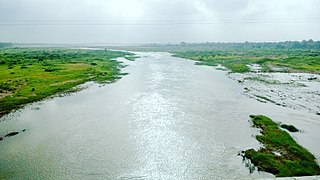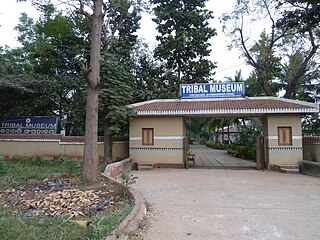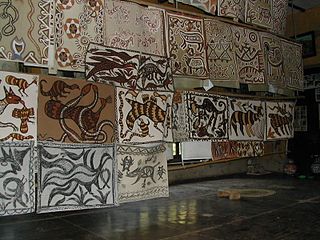
Rangoli is an art form that originates from the Indian subcontinent, in which patterns are created on the floor or a tabletop using materials such as powdered lime stone, red ochre, dry rice flour, coloured sand, quartz powder, flower petals, and coloured rocks. It is an everyday practice in many Hindu households, however making it is mostly reserved for festivals and other important celebrations as it is time-consuming. Rangolis are usually made during Diwali or Tihar, Onam, Pongal, and other Hindu festivals in the Indian subcontinent, and are most often made during Diwali. Designs are passed from one generation to the next, keeping both the art form and the tradition alive.

Bhil or Bheel refer to various indigenous groups inhabiting western India, including parts of Rajasthan and Madhya Pradesh and are also found in distant places such as Bengal and Tripura. They speak various languages of Indo-Aryan origin, owing to language shift, collectively referred to as the Bhil languages. Bhils are divided into a number of endogamous territorial divisions, which in turn have a number of clans and lineages.

A thangka is a Tibetan Buddhist painting on cotton, silk appliqué, usually depicting a Buddhist deity, scene, or mandala. Thangkas are traditionally kept unframed and rolled up when not on display, mounted on a textile backing somewhat in the style of Chinese scroll paintings, with a further silk cover on the front. So treated, thangkas can last a long time, but because of their delicate nature, they have to be kept in dry places where moisture will not affect the quality of the silk. Most thangkas are relatively small, comparable in size to a Western half-length portrait, but some are extremely large, several metres in each dimension; these were designed to be displayed, typically for very brief periods on a monastery wall, as part of religious festivals. Most thangkas were intended for personal meditation or instruction of monastic students. They often have elaborate compositions including many very small figures. A central deity is often surrounded by other identified figures in a symmetrical composition. Narrative scenes are less common, but do appear.
A Bhilala is a tribe found in the Malwa and Nimar of the Central Provinces and in Central India. The total strength of the Bhilalas is about 150,000 persons, most of whom reside in the Bhopawar Agency, adjoining Nimar. Only 15,000 were returned from the Central Provinces in 1911. The Bhilalas are commonly considered, and the general belief may in their case be accepted as correct, to be a mixed caste sprung from the invading immigrant Rajputs with Bhils of the Central India hills. The original term was not improbably Bhilwala, and may have been applied to those Rajput chiefs, a numerous body, who conquered small estates in the Bhil country, or to those who took the daughters of Bhil chieftains to wife. The bhilalas in the central province are descendants of male Rajput with female Bhils and take the name of the Rajput clan to which they trace their origin. The Bhilalas are landholders and live like mukhis, Darbar or Thakur.

The Warli or Varli are an indigenous tribe (Adivasi) of western India, living in mountainous as well as coastal areas along the Maharashtra-Gujarat border and surrounding areas. They have their own animistic beliefs, life, customs and traditions, and as a result of acculturation they have adopted many Hindu beliefs. The Warli speak the unwritten Varli language which belongs to the southern zone of the Indo-Aryan languages. Waralis have sub castes such as Murde varli, Davar varali.

Warli painting is tribal art mostly created by the tribal people from the North Sahyadri Range in Maharashtra, India. Warli paintings exist in cities such as Dahanu, Talasari, Jawhar, Palghar, Mokhada, and Vikramgad of Palghar district, and originated in Maharashtra, where it is still practiced today.
The Dhanka or Dhanak are a tribe or caste of India who believe themselves to be aboriginal, although they are unable to assert from whence they came. They are found in Rajasthan, Haryana, Punjab, Uttar Pradesh, Gujarat, Maharashtra, Chhattisgarh and Madhya Pradesh they are no relation with dhanuk kurmi. They are historically Hindu and their occupations have changed over time, as circumstances have dictated for survival. Although similar groups in India are often referred to as adivasi, the Dhanka generally reject this term.
Asur people are a very small Austroasiatic ethnic group living primarily in the Indian state of Jharkhand, specifically within the Gumla, Lohardaga, Palamu, and Latehar districts. They speak Asur, a Munda language.

Patachitra or Pattachitra is a general term for traditional, cloth-based scroll painting, based in the eastern Indian states of Odisha, West Bengal and parts of Bangladesh. Patachitra artform is known for its intricate details as well as mythological narratives and folktales inscribed in it. Pattachitra is one of the ancient artworks of Odisha, originally created for ritual use and as souvenirs for pilgrims to Puri, as well as other temples in Odisha. Patachitras are a component of an ancient Bengali narrative art, originally serving as a visual device during the performance of a song.

The Rathva or Rathwa is a Subcaste of the Koli caste found in the Indian state of Gujarat. Rathava Kolis were agriculturist by profession and turbulent by habits but now lives like Adivasis such as Bhil because of their neighborhood
Here is a list of glossary of Culture of India in alphabetical order:

Chhota Udaipur district is a district in the state of Gujarat in India. It was carved out of the Vadodara district on 26 January 2013 with its headquarters at Chhota Udaipur town and is the 28th district of Gujarat.

Tribal Research Institute Museum, Museum of Tribal Arts and Artifacts, is a museum in Bhubaneswar, Odisha inside the campus of Scheduled Castes & Scheduled Tribes Research & Training Institute. It is popularly known as Tribal Museum and conceptually labeled as Museum of Man. It has life-sized authentic tribal dwellings, created by the tribal craftsmen offers a view of the State's tribal heritage. It has sections which showcase tribal artifacts and objects, focusing on well researched, documented cultural life of tribals of Odisha. It is headed by a Director, who is in the rank of a University Professor, and the administrative control lies in the hands of ST, SC, Minorities, and Backward Classes Welfare Department, Government of Odisha.

Saura painting is a style of wall mural paintings associated with the Saura tribals of the state of Odisha in India. These paintings, also called ikons are visually similar to Warli paintings and hold religious significance for the Sauras.
Sohrai is a harvest festival of the Indian states of Jharkhand, West Bengal, Chhattisgarh, Odisha, and Bihar. It also called cattle festival. It is celebrated after harvest and coincide with Govardhan Puja of Diwali festival. In Santal Parganas it is celebrated in the Month of January. It is celebrated by Bhumij, Sadan, Oraons, Ho, Munda and Santal among others.

Idital or Edital is a form of Indian painting from the state of Odisha. It is a kind of Saura painting that was invented and is practiced by the Sora people who mostly live in Rayagada, Gajapati and Koraput districts of Odisha. The artisans paint Idital as a symbol of devotion to the tribal deity "Idital" or "Edital". Each piece of Idital painting contains symbols and signs and each one of them convey a distinct meaning. "Jodisum" and "Jananglasum" are two known Idital styles.

Bhuri Bai is an Indian Bhil artist. She was born in Pitol village, situated on the border of Madhya Pradesh and Gujarat. Pitol is a village of Jhabua district in Madhya Pradesh. Bhuri Bai belongs to the community of Bhils, the largest tribal group of India. She has won many awards including the highest state honour accorded to artists by the Madhya Pradesh government, the Shikhar Samman. She was awarded India's fourth highest civilian award the Padma Shri in 2021.
The National List of Intangible Cultural Heritage (ICH) of India is an attempt to recognize the diversity of Indian culture embedded in its intangible heritage. It aims to raise awareness about the various intangible cultural heritage elements from different states of India at national and international level and ensure their protection.

Kawant fair is a fair of Bhil and koli tribe of Chhota Udaipur area which is held in Kwant village immediately after Holi festival.

Sohrai and Khovar are aboriginal methods of wall painting or mural prevalent in the eastern part of India, particularly in the Hazaribagh district of Jharkhand. The art is related to the festival of Sohrai which is celebrated during the autumn months after the Hindu festival of Diwali. Khovar painting specifically relates marriage rituals among the tribes in the region. It is celebrated after the monsoon season and at the start of the paddy harvest season.














